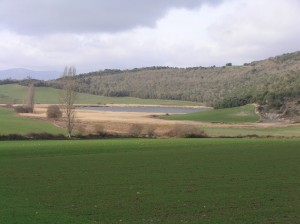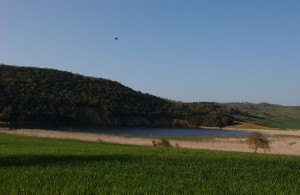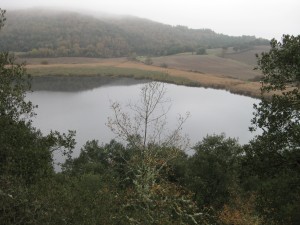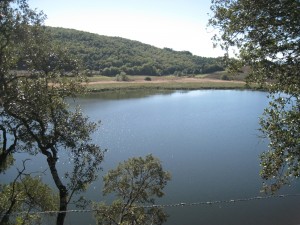Name of the site: Caicedo Yuso y Arreo Lake.
Protection categories: Included in the SAC ES2110007 Caicedo Yuso eta Arreoko lakua / Lago de Caicedo Yuso y Arreo.
Locality: Belongs to the council of Caicedo Yuso, municipality of Lantarón, Province of Álava.
Region: Basque Country.
Surface area: 25 hectares.
Altitude: 655 metres.
Coordinate reference: 30TWN0036, 30TWN0136.
See PDF map
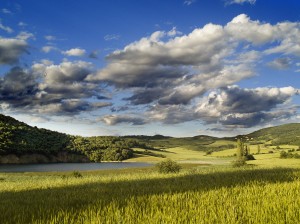
The Caicedo Yuso y Arreo Lake covers a surface area of 136 ha, embracing the lacustrine ecosystem (together with the saline spring), the neighbouring farm land and several clumps of trees that cover the small elevations around the wetland.
Located at an elevation of 650 m above sea level, the area has a small supply basin, complete with a saline spring. The area is the only permanent lacustrine system in the Basque Country and one of the only two on the Iberian Peninsula formed on salt chimneys. It has two subsystems, one of which is lacustrine and the other palustrine, both closely related. The palustrine subsystem, which covers two thirds of the surface area, forms part of a layer of water up to 3-4 metres deep with gentle inclines and a substratum colonised by submergent macrophytes and helophytes. The lacustrine subsystem is very deep (more than 20 m), thereby favouring thermal stratification, and has slightly alkaline, highly mineralised waters which would define it as a subhaline system, albeit with marked differentiation in terms of both time and space.
- MOST IMPORTANT VALUES
Uniqueness
The presence of habitat “3190 Lakes of gypsum karst” is of particular relevance, given that Spain, together with Lithuania, has the finest examples of habitats of this kind in Europe. They are not, however, common in Spain, which only has examples at 8 sites. In the palustrine subsystem, the presence of habitat “7210* Calcareous fens with Cladium mariscus and species of the Caricion davallianae”, only present at 8 sites in the Autonomous Community of the Basque Country, is worthy of mention. Another relevant habitat of community interest in the area is “7230 Alkaline fens”. Another rare habitat in the Autonomous Community of the Basque Country is “1410 Mediterranean salt meadows (Juncetalia maritimae)”, with just two examples, one of which is found in the area of this lake.Biological and ecological values
The lake possesses a mosaic of habitats associated with its aquatic environment, all closely related to one another. Around the basin of the lake (HCI 3190), there is a ring of bulrush beds with alkaline mire (HCI 7210* and 7230) and a saline spring (HCI 1410). This combination is surrounded by intensive crops, dry grasslands (HCI 6210*) and wooded areas (HCI 9240 and 9340).Historical and paleoecological values
The peat-forming habitats in Arreo, which are calcareous in nature, do not possess deposits of relevance from a paleoecological point of view.Habitats of Community Interest
- 1410 Mediterranean salt meadows.
- 1510* Mediterranean salt steppes (Limonietalia).
- 3190 Lakes of gypsum karst.
- 6210 Semi-natural dry grasslands and scrubland facies on calcareous substrates (Festuco-Brometalia).
- 6210* Previous habitat with important orchid sites.
- 7210* Calcareous fens with Cladium mariscus and species of the Caricion davallianae
- 7230 Alkaline fens.
- 9230 Galicio-Portuguese oak woods with Quercus robur and Quercus pyrenaica.
- 9240 Quercus faginea and Quercus canariensis Iberian woods.
- 9340 Quercus ilex and Quercus rotundifolia woods.
Flora
The most relevant flora species at the Caicedo Yuso y Arreo Lake are Berula erecta EN, Puccinellia hispanica EN, Utricularia australis EN, Puccinellia fasciculata VU, Cistus crispus NT and Juncus acutus NT.Fauna
The most noteworthy presences are those of the aquatic coleopteron Gyrinus paykulli, the only known population of which on the Iberian peninsula is found here, Coenagrion mercuriale, which is rare in the Autonomous Community of the Basque Country, the woodland lepidopteron (Euphydryas aurinia) and, until very recently, the autochthonous crayfish (Austropotamobius pallipes). The only autochthonous species of fish fauna now found in the lake is the tench (Tinca tinca). Historically, the European eel (Anguilla anguilla) and the Ebro barbel (Barbus graellsi) have also been cited. 29 bird species, several of which are nesting species, have also been recorded in what is strictly the wetland, as have 8 species of amphibian, 2 reptiles (the water snakes Natrix natrix and N. maura) and, amongst the different mammals, the south-western water vole (Arvicola sapidus) and Daubenton’s bat (Myotis daubentoni).- PHOTOS



